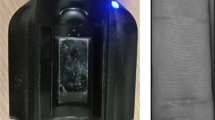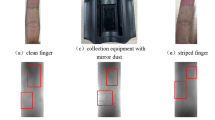Abstract
Traditional inpainting methods obtain poor performance for finger vein images with blurred texture. In this paper, a finger vein image inpainting method using Neighbor Binary-Wasserstein Generative Adversarial Networks (NB-WGAN) is proposed. Firstly, the proposed algorithm uses texture loss, reconstruction loss, and adversarial loss to constrain the network, which protects the texture in the inpainting process. Secondly, the proposed NB-WGAN is designed with a coarse-to-precise generator network and a discriminator network composed of two Wasserstein Generative Adversarial Networks with Gradient Penalty (WGAN-GP). The cascade of a coarse generator network and a precise generator network based on Poisson fusion can obtain richer information and get natural boundary connection. The discriminator consists of a global WGAN-GP and a local WGAN-GP, which enforces consistency between the entire image and the repaired area. Thirdly, a training dataset is designed by analyzing the locations and sizes of the damaged finger vein images in practical applications (i.e., physical oil dirt, physical finger molting, etc). Experimental results show that the performance of the proposed algorithm is better than traditional inpainting methods including Curvature Driven Diffusions algorithm without texture constraints, a traditional inpainting algorithm with Gabor texture constraints, and a WGAN inpainting algorithm based on attention mechanism without texture constraints.












Similar content being viewed by others
References
Liu T, Liu H, Chen ZZ et al (2018) Fast blind instrument function estimation method for industrial infrared spectrometers. IEEE Trans Industr Inform 14(12):5268–5277
Liu T, Liu H, Li YF et al (2019) Efficient blind signal reconstruction with wavelet transforms regularization for educational robot infrared vision sensing. IEEE/ASME Trans Mechatron 24(1):384–394
Liu T, Liu H, Li YF et al (2020) Flexible FTIR spectral imaging enhancement for industrial robot infrared vision sensing. IEEE Trans Industr Inform 16(1):544–554
Rudin LI, Osher S, Fatemi E (1992) Nonlinear total variation based noise removal algorithms. Physica D Nonlinear Phenomena 60(1-4):259–268
Chan TF, Shen JH (2001) Nontexture inpainting by curvature-driven diffusions. J Vis Commun Image Represent 12(4):436–449
Criminisi A, Perez P, Toyama K (2004) Region filling and object removal by exemplar-based image inpainting. IEEE Trans Image Process 13(9):1200–1212
Yang H, Shen L, Yao Y D, et al. (2020) Finger vein image inpainting with gabor texture constraints. IEEE Access 8:83041–83051
Okajima K (1998) The gabor function extracts the maximum information from input local signals. Neural Netw 11(3):435–439
Liu T, Li YF, Liu H et al (2019) RISIR: Rapid infrared spectral imaging restoration model for industrial material detection in intelligent video systems. IEEE Trans Industr Inform. https://doi.org/10.1109/TII.2019.2930463
Fu Y, Xiang T, Jiang YG et al (2018) Recent advances in zero-shot recognition: toward data-efficient understanding of visual content. IEEE Signal Process Mag 35(1):112–125
Ren S, He K, Girshick R et al (2017) Faster R-CNN: Towards real-time object detection with region proposal networks. IEEE Trans Pattern Anal I Mach Intell 39(6):1137–1149
Salimans T, Goodfellow I, Zaremba W et al (2016) Improved techniques for training gans. Adv Neural Inf Process Syst 29:2234–2242
Iizuka S, Simo-Serra E, Ishikawa H (2017) Globally and locally consistent image completion. ACM Trans Graph 36(4):1–14
Li Z, Liu H, Zhang Z et al (2021) Learning knowledge graph embedding with heterogeneous relation attention networks. In: IEEE Transactions on neural networks and learning systems, https://doi.org/10.1109/TNNLS.2021.3055147
Wang Q, Fan H, Zhu L et al (2019) Deeply supervised face completion with multi-context generative adversarial network. IEEE Signal Proc Lett 26(3):400–404
Gao R, Grauman K (2017) On-demand learning for deep image restoration. In: IEEE International conference on computer vision, pp 1095–1104
Pathak D, Krahenbuhl P, Donahue J, et al. (2016) Context encoders: feature learning by inpainting. In: IEEE Conference on computer vision and pattern recognition, pp 2536–2544
Yu J, Lin Z, Yang J, et al. (2018) Generative image inpainting with contextual attention. In: IEEE/CVF Conference on computer vision and pattern recognition, pp 5505–5514
Gulrajani I, Ahmed F, Arjovsky M, et al. (2017) Improved Training of Wasserstein GANs. Adv Neural Inf Process Syst 30:5769–5779
Hore A, Ziou D (2010) Image quality metrics: PSNR vs SSIM. In: 20th International conference on pattern recognition, pp 2366–2369
Zhang Z, Li Z, Liu H et al (2020) Multi-scale dynamic convolutional network for knowledge graph embedding. IEEE Trans Knowl Data Eng. https://doi.org/10.1109/TKDE.2020.3005952
Liu H, Fang S, Zhang Z et al (2021) MFDNet: Collaborative Poses Perception and Matrix Fisher Distribution for Head Pose Estimation. IEEE Trans Multimedia. https://doi.org/10.1109/TMM.2021.3081873
Yu F, Koltun V (2016) Multi-scale context aggregation by dilated convolutions. ICLR. arXiv:1511.07122
Clevert DA, Unterthiner T, Hochreiter S (2015) Fast and accurate deep network learning by exponential linear units (ELUs). Comput Sci. arXiv:1511.07289
Takiyama R, Ono N (1989) A least square error estimation of the center and radii of concentric arcs. Pattern Recogn Lett 10(4):237–242
Hamouchene I, Aouat S (2014) A cognitive approach for texture analysis using neighbors-based binary patterns. In: IEEE International conference on cognitive informatics and cognitive computing, pp 94–99
Pollard D (1991) Asymptotics for least absolute deviation regression estimators. Econ Theory 7 (2):186–199
Rez P, Gangnet M, Blake A (2003) Poisson image editing. Acm Trans Graph 22(3):313–318
Isola P, Zhu YJ, Zhou T et al (2017) Image-to-image translation with conditional adversarial networks. In: IEEE Conference on computer vision and pattern recognition, pp 1125–1134
Lidong H, Wei Z, Jun W et al (2015) Combination of contrast limited adaptive histogram equalisation and discrete wavelet transform for image enhancement. Image Proc Iet 9(10):908–915
Author information
Authors and Affiliations
Corresponding author
Additional information
Publisher’s note
Springer Nature remains neutral with regard to jurisdictional claims in published maps and institutional affiliations.
Rights and permissions
About this article
Cite this article
Jiang, H., Shen, L., Wang, H. et al. Finger vein image inpainting using neighbor binary-wasserstein generative adversarial networks (NB-WGAN). Appl Intell 52, 9996–10007 (2022). https://doi.org/10.1007/s10489-021-03017-7
Accepted:
Published:
Issue Date:
DOI: https://doi.org/10.1007/s10489-021-03017-7




